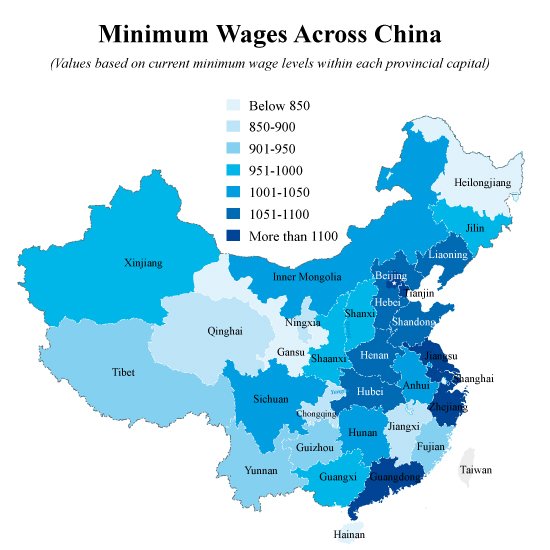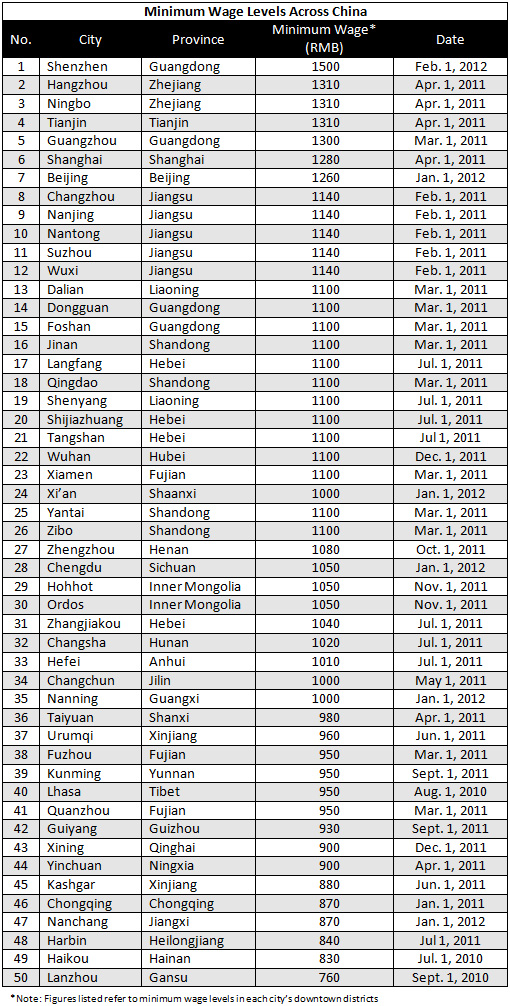Minimum Wage Levels Across China
Feb. 22 – As wage levels in China have recently come under scrutiny (Foxconn, a key supplier for Apple, raised salaries at their China factories by 25 percent earlier this week following international criticism), the country’s actual minimum wage levels have been in place for decades and have been rapidly rising across the board.
The Chinese government, as a matter of national policy, has been increasing minimum wage levels by 15 percent to 25 percent annually for the past three years. Rates vary by region and are set by each respective local government – calculated in tandem with a number of other indicators, including relations to the local housing market. They are also set to rise over the coming years as China looks to shift its economy towards a more balanced consumer society. To achieve that goal, Chinese citizens need to have increasing levels of disposable income.
How this is manifesting itself is an interesting case study that is perhaps best and most easily-defined by the map and accompanying table below. With such visual aids, it is easy to see at a glance that the well-known coastal provinces boast relatively higher minimum wage levels than the more slow-to-develop western areas. However, there are local anomalies. Haikou, the capital city of Hainan Province, maintains a minimum wage lower than that of Kashgar for example. The map below is color-coded based on the current monthly minimum wage levels in the downtown area of each region’s respective capital city. That means for Fujian Province we used Fuzhou and not Xiamen as the key indicator, and for Guangdong Province we used Guangzhou and not Shenzhen. For specific city-by-city figures, the table below lists the monthly minimum wage levels of 50 major cities across China.


Minimum wages are of course the legal minimum, and increasingly in China are not applicable in any sensible business model – assuming one wishes to retain workers. Also important to note is that, on top of wages, employers must also contribute mandatory social welfare benefits for each of its employees. This again varies by region, but can add an additional 40 percent to 50 percent on top of each Chinese employee’s base salary. We covered all this in detail yesterday in our article “Mandatory Social Welfare Benefits for Chinese Employees.”
Dezan Shira & Associates is a specialist foreign direct investment practice and can advise international companies investing in China on the country’s complete legal, tax and operational issues. The firm was established in 1992 and maintains 12 offices throughout China, in addition to practicing in Hong Kong, India, Vietnam and Singapore. For advice on all matters of China HR, payroll and costs, please contact the firm at china@dezshira.com or visit our web site at www.dezshira.com.
Related Reading
 China’s Social Insurance Law
China’s Social Insurance Law
A summary of some of the key points in the newly implemented Social Insurance Law, which covers a great deal more than just incorporating foreigners into the system. We explain the costs and benefits of participation by foreign employees to both companies and individuals as well as take a look at some of the trends across the country relating to the implementation of the law.
 Human Resources in China
Human Resources in China
Specifically designed to cover the most important issues relating to managing a Chinese workforce, this guide details the HR issues that both local managers in China and investors looking to establish a presence on the mainland should be aware about.
Mandatory Social Welfare Benefits for Chinese Employees
Calculating Overtime Payments in China
China Vows to Increase Wages and Improve Employment
China’s Provincial GDP Figures in 2011
China’s Provincial Retail Statistics for 2011
Top 50 Chinese Cities by Investment Potential
- Previous Article Local Governments Reduce Tax Burdens for Entertainment Industry
- Next Article Bank of China Moves to Enter London Metals Exchange









